Insect Feeding Damage
Small pits or tiny holes on leaf surfaces
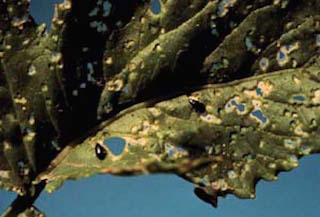
Cause
Flea beetles (various species).
Treatment
Fruit is rarely damaged. Treatment is usually not required. Control by eliminating weeds near field edges, and eliminating overwintering sites by removing crop residue.
Pale leaf veins, curling crinkling, or puckering leaves, which turn brown and are often stunted
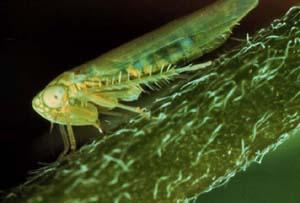 |
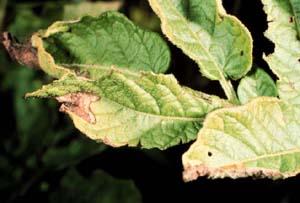 |
Cause
The potato leafhopper (Empoasca fabae), a small (1/8" long) light green insect.
Treatment
The potato leafhopper does not overwinter in Minnesota, but rather is carried north by wind currents each summer. Avoid planting potatoes near alfalfa, which is another preferred food source for this insect.
Leaf skeletonization or chewing damage on leaf edges in late spring or early summer
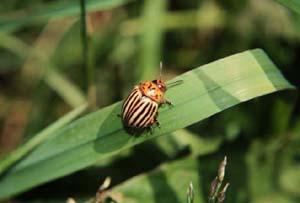 |
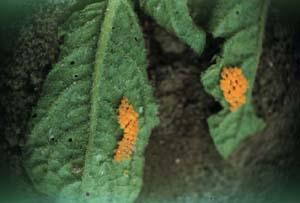 |
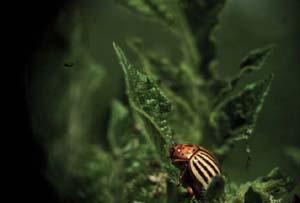 |
Cause
The Colorado potato beetle (Lepitinotarsa decemilineata). Both adult beetles and larva feed on leaves. The larva is more destructive than adult beetles.
Adult beetles are about 3/8 of an inch long with tan heads and conspicuous black and yellow-white striped bodies. Larvae are 1/8 to 1/2 inch long with soft, reddish-tan bodies. On either side of the body larva have 2 noticeable rows of black spots.
Yellowish-orange egg masses may also be noticeable on the undersides of leaves in clumps of 20 to 40 eggs.
Adult beetles emerge from underground in June feeding on the upper leaves of young plants and laying eggs. In parts of southern Minnesota a 2nd generation may occur. After eggs hatch larvae emerge and begin feeding. These immature beetles overwinter underground where they pupate before emerging as adults in the spring.
Feeding damage often begins at leaf edges progressing inward resulting in complete defoliation in badly infested fields. Often times leaf blades are consumed while the leaf veins are left intact creating a skeletonized leaf.
Treatment
Control of the Colorado potato beetle is difficult. This insect develops rapid and frequent resistance to pesticides rendering them ineffective. Bt formulations are commercially available for control of this insect.
Row covers may offer some physical protection against infestation, but must be anchored to prevent ingress by the beetle. Other control practices involve frequent crop rotations--avoiding consecutive plantings of tomato, potato, and eggplant year after year.
Colorado potato beetle populations of more than 1 beetle for every 2 plants should be considered a significant action threshold and control action should be taken.
Yellow leaves with a shiny or sticky leaf surface
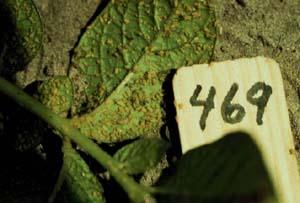 |
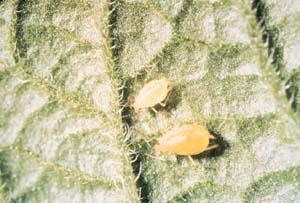 |
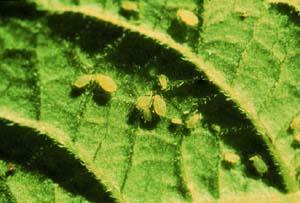 |
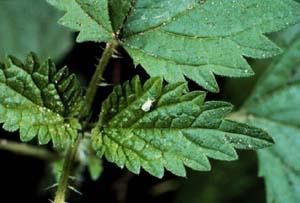 |
Cause
Aphids and whiteflies (various species). These small soft-bodied insects are less than 1/8 inch long and appear in a variety of colors. Using piercing-sucking mouth parts, aphids and whiteflies remove plant sap and often spread disease in the process. Ants are often drawn to their sticky excrement.
Treatment
Treatment is usually not required as many natural predators such as lady beetles exist. However in widespread infestations (more than 50% of all leaves in field infested), action may be necessary. Low toxicity insecticidal soaps and horticultural oils are highly effective.
Spots, Lesions, Discoloration on Leaves or Tubers
Irregular-shaped black, brown, or purple lesions
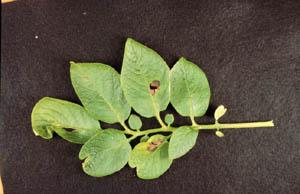
Cause
Late blight (Phytophthora infestans), a fungus-like organism often with white mold on the undersides of leaves.
Treatment
No resistant varieties are available. Rotate crops annually, and remove crop debris at the end of each season. Approved fungicides include copper formulations.
Concentric ring-shaped spots
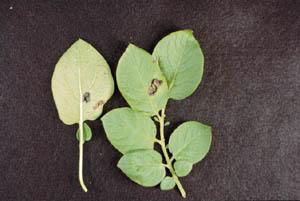
Cause
Early blight (Alternaria solani), a fungus.
Treatment
Avoid over-watering, wounding or mechanical damage to growing tubers. Remove crop debris and rotate crops annually. Eliminate alternate hosts for the disease especially weeds like nightshade. Approved fungicides include copper formulations.
Rapid wilting
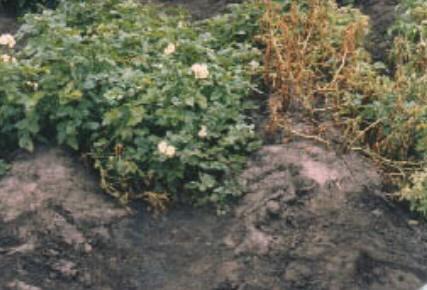
Cause
Verticillium wilt, a fungal disease. In early stages wilting begins on lower leaves. As the disease progresses, the entire plant wilts and dies. Dark streaks can be seen in the vascular tissue of cut stems.
Treatment
Rotate crops annually. Do not plant potatoes in the same field where tomato or eggplant was grown the previous season. Approved fungicides may be available, contact your local Extension agent for current recommendations. Resistant varieties are available, including 'Century Russet' and 'Ranger Russet'.
Black, decaying stems
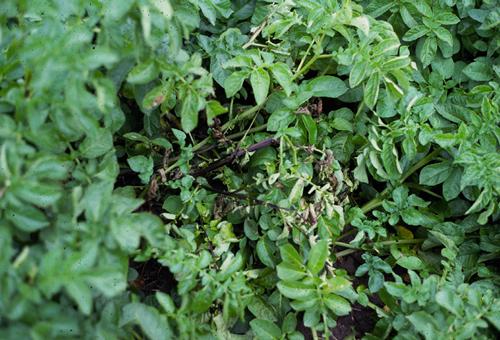
Cause
Black leg (Erwinia carotover), a bacterial disease. Decay starts at the bottom of the plant and moves upward--often stunting growth. Infection is caused by mechanical damage to wet plants, or by excessive irrigation.
Treatment
Remove infected plants by hand. Avoid working around wet plants. Approved antibiotics are available for extreme cases, however they should be used with caution.
Corky, woody, or bark-like raised or sunken lesions
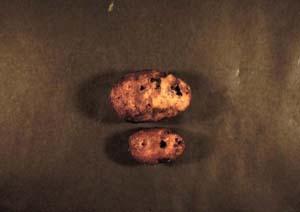
Cause
Common scab (Streptomyces scabies). Lesions begin as raised areas, then become deep and sunken during wet weather.
Treatment
Rotate crops annually, removing crop debris at the end of each season. Do not follow other root crops. Use disease-free seed. Resistant cultivars include 'Superior' and 'Norland.' If the soil pH is greater than 5.2 acidify soil.
Brown lesions with white mold
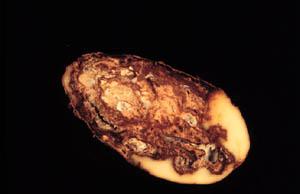
Cause
Fusarium dry rot.
Treatment
Use disease-free seed potatoes, and seed potatoes treated with fungicide. Avoid mechanical damage to tubers.
Soft, rotting tubers
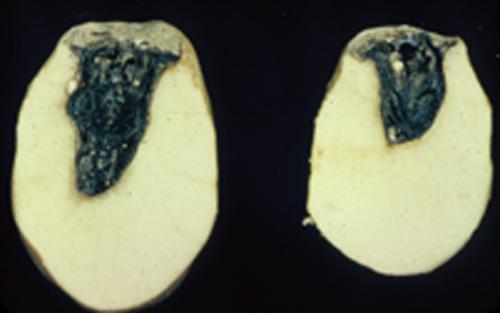
Cause
Black leg (Erwinia carotover), a bacterial disease. Decay starts at the bottom of the plant and moves upward--often stunting growth. Infection is caused by mechanical damage to wet plants, or by excessive irrigation.
Treatment
Remove infected plants by hand. Avoid working around wet plants. Approved antibiotics are available for extreme cases, however they should be used with caution.
Purple or black lesions
Cause
Early blight (Alternaria solani), a fungus.
Treatment
Avoid over-watering, wounding or mechanical damage to growing tubers. Remove crop debris and rotate crops annually. Eliminate alternate hosts for the disease especially weeds like nightshade. Approved fungicides include copper formulations.
Brown discoloration within the tuber

Cause
Verticillium wilt, a fungal disease. In early stages wilting begins on lower leaves. As the disease progresses, the entire plant wilts and dies. Dark streaks can be seen in the vascular tissue of cut stems.
Treatment
Rotate crops annually. Do not plant potatoes in the same field where tomato or eggplant was grown the previous season. Approved fungicides may be available, contact your local Extension agent for current recommendations.